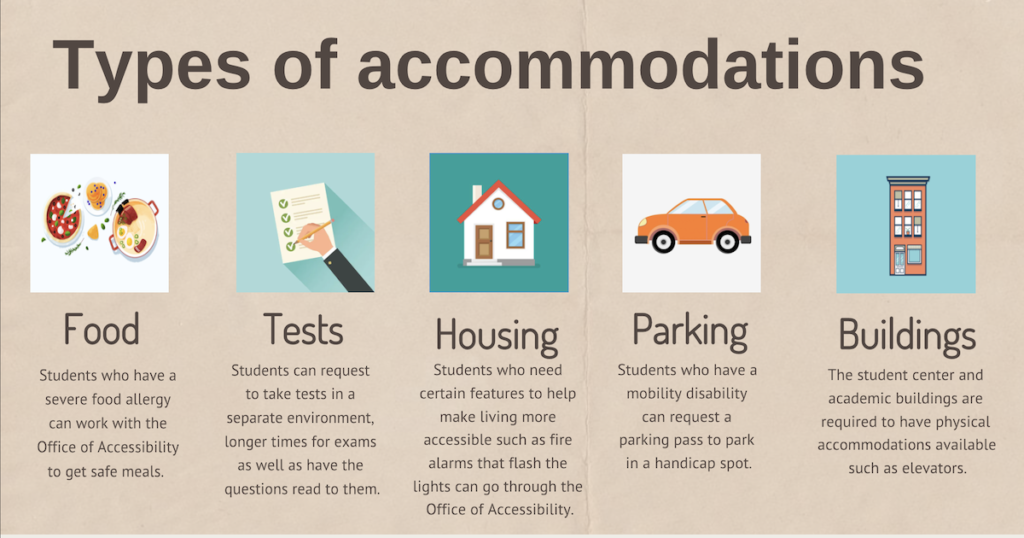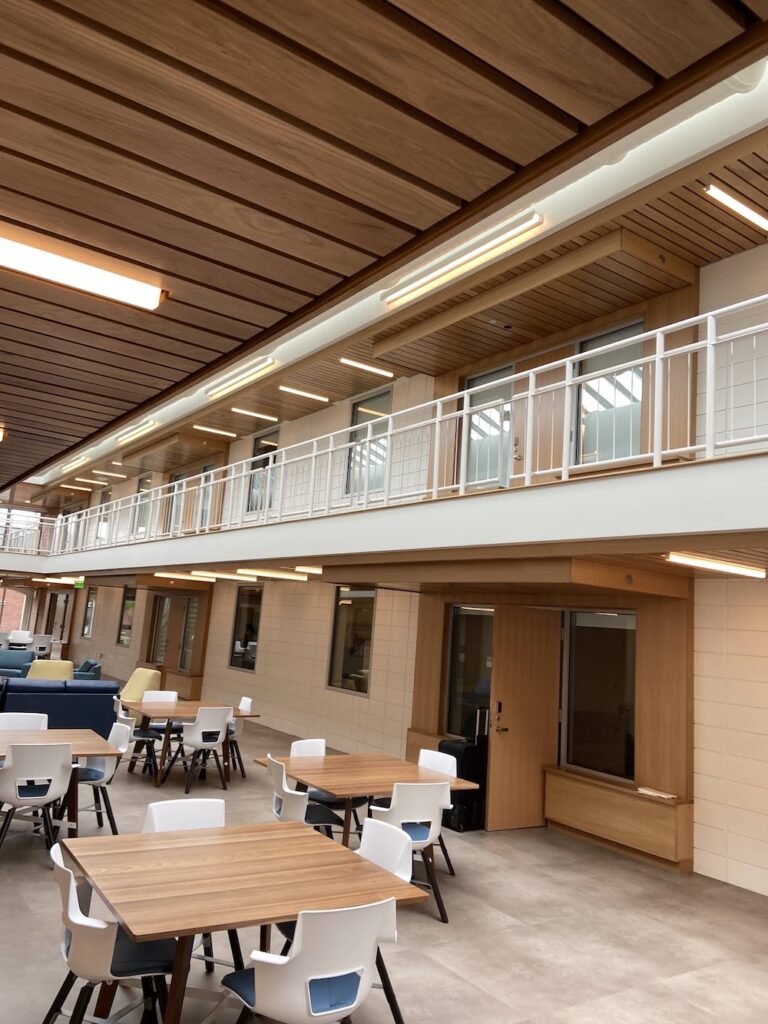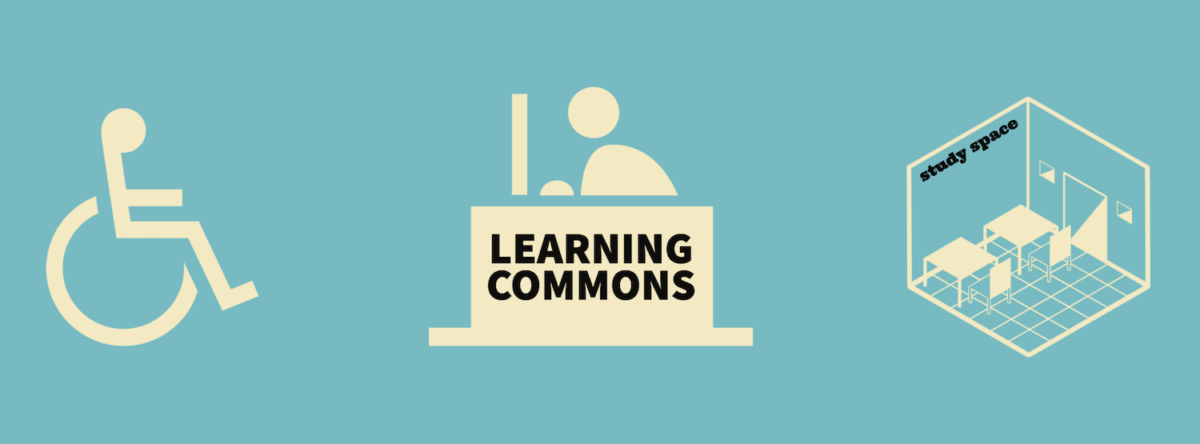About 30% of students at Quinnipiac have disclosed a disability, Kate Palumbo, director of the Office of Accessibility said. Since the university has a significant number of students with disabilities, it needs to be accessible for everyone both in physical aspects as well as virtual, Palumbo said.
“We don’t just do academic accommodations,” Palumbo said. “Our office definitely has a keen eye on all areas of accessibility across the campus.”
Palumbo said about 70% of all undergraduate and graduate students have used the Office of Accessibility at least once.
“We really refer to it like the academic gym, not the academic hospital where you go, and you’re in trouble,” Palumbo said. “But you come here to learn how to make your brain work best.”

Ted Czepiga, coordinator of Accessibility Services, began working at Quinnipiac this semester and said he appreciates the diversity of needs the Office of Accessibility offers. He said his goal is to help as many students as possible succeed.
“I try to reiterate to each student is the importance for them to advocate for themselves,” Czepiga said. “Always being proactive instead of reactive, it’s much easier if we address things, the front end than the back end.”
Carter Quinn, a junior computer information systems major, has an accommodation where uses extended time on tests. He is also a student worker for the Office of Accessibility.
“A lot of it is just dealing with students to help with getting their accommodations,” Quinn said. “So they have some kind of disability, they need help getting the forms they need … and we approve it. Then we send them a letter that they can send to the professors saying what exactly accommodations they can get.”
He said students “love” the extended time for tests as an accommodation since they have to take their exams in the Learning Commons, which is a subset of the Office of Accessibility, in their own rooms, so there are no distractions or feelings of anxiety surrounding how long it takes to complete the exam.
“They take their test and … not have to deal with everyone else finishing first and being the last one in the class,” Quinn said. “So it’s great having that space. Students really, really love that.”
Palumbo and Czepiga said the trends in their department reflected the effects of the COVID-19 pandemic. Czepiga said anxiety and other mental health issues are on the rise, which has translated into the accommodation requests the Office of Accessibility receives.
“I think just because students haven’t been in the classroom in a long time or just social life has kind of dwindled because of the pandemic and not having the normal college experience,” Czepiga said.
Palumbo said that people who had learning disabilities or executive functioning disabilities struggled when learning became virtual in the early part of the pandemic. She also noted that some students ended up learning better in a virtual environment.
“It really comes down to a student’s strengths and subsequent challenges,” Palumbo said. “This behind-the-screen stuff didn’t really work the best for certain students. Then on the other hand, you have students that are still now requesting to be fully remote in on Zoom due to disability related issues, right. So I feel like it’s kind of split.”
Something that Palumbo noted was that in the fall 2020 semester, around 500 less students disclosed a disability than typical, which is around 1,500 students.
“Their professors were accommodating exams and that extended time, or they didn’t need a reduced distraction environment because they’re sitting in their dorm rooms, and they were able to create that own space for themselves,” Palumbo said.
All universities whether they are public or private institutions must provide equal access to education and extracurricular activities for all of its students, according to the Americans with Disabilities Act of 1990.
The ADA outlines specific guidelines establishments must follow such as if there are multi-stall bathrooms, they must have a handicap accessible stall. The stall itself must be 60 inches by 60 inches with a minimum size of 32 inches for the door.
Quinnipiac is up-to-code with ADA compliance for its buildings, Palumbo said.
One of the most commonly known ADA requirements for a building is elevators. Most multi-story buildings are required to have elevators so people with a physical disability utilize it.
Troup, Larson and Perlroth Residence Halls do not have elevators. Palumbo clarified that although this may appear to be against ADA requirements, it isn’t since the guidelines state that elevators are not needed in a building with less than three stories.
Palumbo also said that in all three buildings there are handicap-accessible suites available on the first floor for students who need it.
Cortney Hanula, a senior business major, who lived on the second floor of Troup last year said when she broke her ankle, it was a difficult experience to not have an elevator along with the extra challenges COVID-19 added..
“I was shocked to learn there wasn’t an elevator,” Hanula said. “I asked what I should do and couldn’t believe what they suggested.”
Hanula asked Residential Life how she would get up to her room since she was placed in a non-weight bearing cast. Hanula said she received an email back telling her she could move into Sahlin Residence Hall, which was being used as quarantine housing last year.
Although the building had an elevator and she would be able to get in and out of her room easier, Hanula was upset that she would not be able to live with her friends.
“I chose to live with these people and since I’d be in the cast for eight weeks, that’s a lot of time to be spending alone,” Hanula said. “I understand that technically they were offering me equal access to buildings with my short-term disability, but I didn’t want to live alone in a building with people who were exposed to COVID.”

After denying the offer to live in Sahlin, Hanula attempted to continue living in Troup by “hopping up the stairs every day.”
“It was so bad,” Hanula said. “I could only handle that for two weeks, then I just decided to go home because my mental health was suffering and my physical health was obviously not good either.”
Hanula said that even if the university is following ADA guidelines, it should offer more than the bare minimum for its students.
“[My experience] made me think about people with long-term disabilities here,” Hanula said. “What if I had a friend with a long-term disability who wanted to visit me in Troup? Are they just supposed to compromise and not go there?”
Palumbo said that sometimes the Office of Accessibility works to accommodate students despite some obstacles that cannot be changed overnight such as the lack of elevators in Troup, Larson and Perlroth.
The Office of Accessibility staff operates during working hours, but recognize that problems arise outside those scheduled hours. Palumbo said that most of the staff members are available when they go home to help resolve any issues.
“I think we’re pretty diligent,” Palumbo said. “Most of us are pretty much on our email outside of sleeping hours. But we always tell students, if there’s a concern to get in touch with public safety, first and foremost.”
Professors are another part of the learning paradigm that help students with different abilities succeed. Marcos Scauso, a political science professor at Quinnipiac University, said making his classroom accessible is important.
“It’s just a matter of, you know, learning a tiny bit of a strategy that helps others enormously,” Scauso said.
He also said that he thinks the university has more to do in terms of improving its accessibility for students. He said that explaining simple accommodations with in the classroom such as turning on the automatic captioning on recorded PowerPoints would make a huge difference for students.
“There are things that are very easy to do, that we don’t realize make a world of difference for others,” Scauso said.
One thing Quinn said he wishes all Quinnpiac students knew was that getting his accommodation was easy and he encourages other students to apply for one if they think it could benefit them at all.
“We want to be their resource for getting their needs, we want to help them with whatever they need,” Quinn said. “So we’re going to do whatever we can, but if we can’t help them, we’re going to point them in the right direction.”

